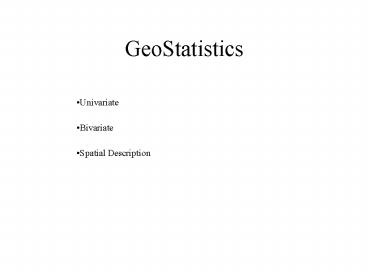GeoStatistics - PowerPoint PPT Presentation
1 / 17
Title:
GeoStatistics
Description:
parallelepiped. feature space. Unclassified Options. parametric rule. unclassified. Overlap Options ... Parallelepiped. cluster mean. Candidate pixel. Band A ... – PowerPoint PPT presentation
Number of Views:213
Avg rating:3.0/5.0
Title: GeoStatistics
1
GeoStatistics
- Univariate
- Bivariate
- Spatial Description
2
Univariate
- One Variable
- Frequency (table)
- Histogram (graph)
- Do the same thing (i.e count of observations in
intervals or classes - Cumulative Frequency (total below cutoffs)
3
Summary of a histogram
- Measurements of location (center of distribution
- mean (m µ x )
- median
- mode
- Measurements of spread (variability)
- variance
- standard deviation
- interquartile range
- Measurements of shape (symmetry length
- coefficient of skewness
- coefficient of variation
4
Bivariate
Scatterplots
Correlation
Linear Regression
slope constant
5
Basics for Spatial data
A data layer, grid, raster, or single band of an
image spatial dataset
Rows of b
Columns of b
Total number of bands or layers, the count of
bdimensions
Total number of rows, the count of i
Total number of columns, the count of j
, the total size of b
6
Basics for Spatial Data
And
A cell (pixel or place) having an assigned value
And
Any given i, j pair
Such that
7
Basics for Spatial Data
Therefore the Sum for a single band (grid,
coverage) across all cells (space) is
and the Sum for a single cell (space) across all
bands (grids, coverages) is
8
terms
- Parametric based upon statistical parameters
(mean standard deviation) - Non-Parametric based upon objects (polygons) in
feature space - Decision Rules rules for sorting pixels into
classes
9
Spatial Parameters
the statistical average the central
tendency the spread of the values about the
mean
MEAN Sample Variance Standard Deviation
10
Covariance
measures the tendencies of data file values for
the same pixel, but in different bands, to vary
with each other in relation to the means of their
respective bands.
11
Dimensionality
B the number of bands dimensions . A
multi-dimensional data (feature) space
Measurement Vector
Mean Vector
Feature Space - 2dimensions
190 85
Band B
Band A
12
Spectral Distance
a number that allows two measurement vectors to
be compared
13
ClusteringMinimum Spectral Distance -
unsupervised
Band B
Band A
Band B
Band A
1st iteration cluster mean
2nd iteration cluster mean
14
Classification Decision Rules
- Non-Parametric
- parallelepiped
- feature space
- Unclassified Options
- parametric rule
- unclassified
- Overlap Options
- parametric rule
- by order
- unclassified
- Parametric
- minimum distance
- Mahalanobis distance
- maximum likelihood
- If the non-parametric test results in one unique
class, the pixel will be assigned to that class. - if the non-parametric test results in zero
classes (outside the decision boundaries) the the
unclassified rule applies either left
unclassified or classified by the parametric rule - if the pixel falls into more than one class the
overlap rule applies left unclassified, use the
parametric rule, or processing order
15
Parallelepiped
- Maximum likelihood
- (bayesian)
- probability
- Bayesian, a prior (weights)
Band B
Band A
Minimum Distance
16
Spatial Description
- Data Postings symbol maps (if only 2 classes
indicator map - Contour Maps - Moving Windows
gt heteroscedasticity (values in some region
are more variable than in others) - Spatial
Continuity (h-scatterplots
Spatial lag h (0,1) same x, y1
h(0,0) h(0,3) h(0,5)
correlation coefficient (i.e the correlogram,
relationship of p with h
17
- Correlogram p(h) the relationship of the
correlation coefficient of an h-scatterplot and h
(the spatial lag) - Covariance C(h) the relationship of
thecoefficient of variation of an h-scatterplot
and h - Semivariogram variogram moment of
inertia
OR half the average sum difference between the x
and y pair of the h-scatterplot OR for a h(0,0)
all points fall on a line xy OR as h
points drift away from xy































